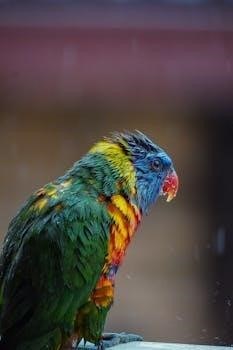Rain Bird SST-900i Manual⁚ An Overview
The Rain Bird SST-900i manual serves as a comprehensive guide for users of this 9-zone indoor irrigation timer. It provides setup instructions, programming details, and troubleshooting tips. Users can optimize their watering schedules and understand timer functionalities.
Key Features of the Rain Bird SST-900i
The Rain Bird SST-900i stands out with its user-friendly design and intuitive zone-by-zone scheduling. This feature allows homeowners to customize watering schedules for up to nine different zones in their yard, catering to the specific needs of each area. The timer’s compatibility with indoor use, including garages and sheds, offers flexible installation options. One-touch seasonal adjustments simplify the process of increasing or decreasing watering durations based on weather conditions, optimizing water usage throughout the year.
The Rain Delay function suspends watering for up to 72 hours, preventing unnecessary irrigation during rainy periods. Furthermore, the SST-900i is compatible with most 24 VAC irrigation valves and supports a master valve or pump start relay, along with a rain sensor for enhanced water conservation. Its lighted buttons provide visibility in low-light conditions, adding to its ease of use. Superior surge protection ensures long-lasting durability, making the SST-900i a reliable choice for efficient lawn and garden irrigation management.
Setting Up the Rain Bird SST-900i
Setting up the Rain Bird SST-900i involves a few straightforward steps to get your irrigation system up and running. Begin by mounting the timer indoors in a suitable location like a garage or shed, protecting it from direct exposure to the elements. Next, connect the 24 VAC power supply to the timer, ensuring a stable power source. Then, wire the irrigation valves to their corresponding zone terminals on the SST-900i, carefully matching each valve to its designated zone.
If you have a master valve or pump start relay, connect it to the appropriate terminals as well. For those wishing to conserve even more water, integrating an optional rain sensor is a great idea. After connecting the wires, secure them in the terminal block and tidy up any loose wiring. Finally, before you start programming, make sure that all connections are secure and that the timer is receiving power. Following these steps will allow you to easily set up the Rain Bird SST-900i.

Programming Zones on the SST-900i
Programming zones on the SST-900i is intuitive, offering zone-by-zone scheduling. This allows custom watering schedules for each yard area. Set watering days, times, and durations independently for optimal water use.
Zone-by-Zone Scheduling
The Rain Bird SST-900i’s zone-by-zone scheduling feature offers unparalleled control over your irrigation system. This intuitive design allows you to customize watering schedules for each zone in your yard, addressing the unique needs of different plant types and soil conditions. Forget about a one-size-fits-all approach; with the SST-900i, you can tailor watering to specific areas, promoting healthier growth and conserving water.
Each zone can be programmed independently, enabling you to set different watering days, start times, and durations. For instance, you might want to water your lawn every other day for 20 minutes, while your flower beds require daily watering for only 10 minutes. With zone-by-zone scheduling, this level of customization is easily achievable.
This feature is especially beneficial for yards with varying microclimates or plant types. Areas that receive more sunlight or have sandy soil may require more frequent watering, while shaded areas or clay soils may need less. By adjusting watering schedules zone by zone, you can ensure that each area receives the optimal amount of water, preventing overwatering or underwatering and promoting lush, healthy growth throughout your yard.
Setting Custom Watering Times
The Rain Bird SST-900i allows for precise control over watering schedules through its custom watering times feature. This functionality enables users to define specific start times for each zone, offering flexibility to align irrigation with optimal conditions and personal preferences. You can set multiple start times per zone, allowing for shorter, more frequent watering cycles, which is particularly beneficial for slopes or clay soils to prevent runoff and ensure better water absorption.
To set custom watering times, navigate to the desired zone using the dial. Then, utilize the programming buttons to select the start times. The SST-900i supports multiple start times, providing the ability to water at different times of the day. This is advantageous for avoiding peak evaporation periods or complying with local watering restrictions.
Experiment with different start times to find what works best for your landscape. Consider factors such as sunlight exposure, soil type, and plant water requirements. By carefully setting custom watering times, you can optimize water usage, promote healthy plant growth, and maintain a vibrant landscape.

Rain Delay Function
The Rain Bird SST-900i includes a convenient rain delay function that allows users to temporarily suspend scheduled watering cycles. This feature is particularly useful during periods of rainfall, preventing overwatering and conserving water resources. The rain delay function can be set for up to 72 hours, providing flexibility to accommodate varying weather patterns.
To activate the rain delay, simply press the designated button on the timer. The display will indicate the duration of the delay. During the rain delay period, all scheduled watering cycles will be paused. Once the delay expires, the timer will automatically resume its normal programming.
This feature is crucial for responsible water management, as it prevents unnecessary irrigation when natural precipitation is sufficient. By utilizing the rain delay function, users can avoid water waste, reduce their water bills, and contribute to environmental conservation. Regularly monitor weather forecasts and utilize the rain delay function whenever rainfall is expected to optimize watering schedules and promote sustainable practices.

Connecting a Rain Sensor
Connecting a rain sensor to the Rain Bird SST-900i allows the system to automatically suspend watering when it rains. Remove the jumper wire and connect the rain sensor wires to the designated terminals for optimal performance.
Removing the Jumper Wire
Before connecting a rain sensor to your Rain Bird SST-900i irrigation timer, it’s crucial to correctly remove the jumper wire. This wire acts as a default connection, allowing the timer to operate without a rain sensor. To install a rain sensor effectively, this connection must be broken.
First, locate the wiring bay at the bottom of the SST-900i unit. You may need to remove a cover to access the terminal block. Look for the terminals specifically marked “RAIN SENSOR.” These terminals will have a small yellow jumper wire connecting them.
Using a small pair of pliers or your fingers, carefully detach the jumper wire from both terminals. Ensure you pull the wire straight out to avoid bending or damaging the terminals. Store the jumper wire in a safe place. Do not discard it, as you may need to reconnect it if you remove the rain sensor in the future.
Removing the jumper wire signals to the timer that a rain sensor is now in use. Without this step, the timer will continue to operate according to its programmed schedule, disregarding any input from the rain sensor. Remember, the system needs this step to function correctly.
Connecting the Rain Sensor Wires
After successfully removing the jumper wire from the “RAIN SENSOR” terminals on your Rain Bird SST-900i, the next step is to connect the rain sensor wires. This connection allows the rain sensor to communicate with the timer, automatically suspending irrigation when rainfall is detected.
Take the two wires from your rain sensor. It generally doesn’t matter which wire connects to which terminal, as the connection is simply a closed or open circuit. Insert one wire into one of the “RAIN SENSOR” terminals. Use a small screwdriver to tighten the terminal screw, securing the wire in place.
Repeat this process with the second wire, inserting it into the remaining “RAIN SENSOR” terminal and tightening the screw. Ensure both wires are firmly connected and cannot be easily pulled out. A loose connection can cause intermittent or complete failure of the rain sensor function.
Once the wires are securely connected, gently tug on each wire to confirm they are properly fastened. Replace the wiring bay cover, if applicable. Your Rain Bird SST-900i is now configured to use the rain sensor to intelligently manage your irrigation schedule, conserving water and protecting your landscape. Test the sensor.

Seasonal Adjustments
The Rain Bird SST-900i offers a convenient feature for seasonal adjustments, allowing you to easily modify watering durations based on the changing needs of your landscape throughout the year. This one-touch adjustment simplifies the process of increasing or decreasing watering times without needing to reprogram each individual zone.
During hotter, drier months, plants typically require more water. The seasonal adjustment feature allows you to increase the watering duration by a percentage. For instance, setting the adjustment to 120% will increase all programmed watering times by 20%. This ensures your plants receive adequate hydration during peak seasons.
Conversely, in rainy or cooler periods, reducing watering times is crucial to prevent overwatering and potential root rot. By setting the seasonal adjustment to a value below 100%, you can decrease the watering duration proportionally. A setting of 80% would reduce all programmed watering times by 20%. Regularly adjusting can promote plant health.
To make seasonal adjustments, consult the user manual. The SST-900i’s seasonal adjustment feature ensures optimal water usage throughout the year, adapting watering schedules to match seasonal conditions.
Troubleshooting Common Issues
The Rain Bird SST-900i, while user-friendly, may occasionally encounter issues. A common problem is the system not watering, often due to a deactivated program. Ensure the dial is correctly set and the program is active. Check the power supply to the timer; verify it’s properly connected. Also, examine the valve wires.
Another potential issue is a zone failing to water; This may indicate a faulty solenoid on the corresponding valve. Test the solenoid with a multimeter; if it’s defective, replace it. Also, check for obstructions in the valve. Clogged valves prevent water flow. Ensure the water supply to the timer is turned on fully.
If the timer displays an error message, consult the manual for specific troubleshooting steps. A frequent problem involves rain sensor interference. Confirm the rain sensor is correctly connected and functioning. Bypass the rain sensor to test.
Incorrect scheduling can also cause problems. Review zone programming. Ensure start times and run times are appropriately set. Refer to the SST-900i manual for guidance.
By systematically addressing these areas, most common issues can be resolved.
Accessing the User Manual and Support
The Rain Bird SST-900i user manual is readily accessible through various channels. A digital copy can often be found on the Rain Bird website. Navigate to the support section and search for the SST-900i model; The manual is typically available as a PDF download. This allows users to view it on computers or mobile devices.
If you prefer a physical copy, check the product packaging. Many units include a printed manual. If misplaced, consider contacting Rain Bird customer service for assistance. Their website also offers FAQs and troubleshooting guides. These resources address common questions and issues.
For direct support, Rain Bird provides a technical support hotline. Check the website for the current phone number and operating hours. Trained professionals can provide assistance with setup, programming, and troubleshooting. Additionally, online forums and communities may offer peer-to-peer support; Sharing experiences can prove invaluable.
Remember to have your model number and purchase date handy. This information helps expedite the support process. Accessing these resources ensures optimal use of the Rain Bird SST-900i.
Where to Find Replacement Parts and Accessories
Finding replacement parts and accessories for the Rain Bird SST-900i is generally straightforward. Start by checking with authorized Rain Bird dealers. These dealers often carry a range of components specifically designed for Rain Bird products. You can locate authorized dealers through the Rain Bird website’s dealer locator tool.
Major home improvement stores, such as Home Depot and Lowe’s, also typically stock Rain Bird products. Their irrigation sections may have replacement parts and accessories available; Online retailers, like Amazon, are another convenient option. Be sure to verify the part’s compatibility with the SST-900i model before purchasing.
For specific parts not readily available, consider contacting Rain Bird directly. Their customer service department can provide information on sourcing hard-to-find items. When ordering, have the timer’s model number and the part number handy. This ensures you receive the correct replacement.
Accessories, such as rain sensors, can enhance the SST-900i’s functionality. These accessories are usually available from the same sources as replacement parts. Remember to consult the user manual for compatible accessories and proper installation instructions. Proper sourcing ensures the longevity of your Rain Bird SST-900i.